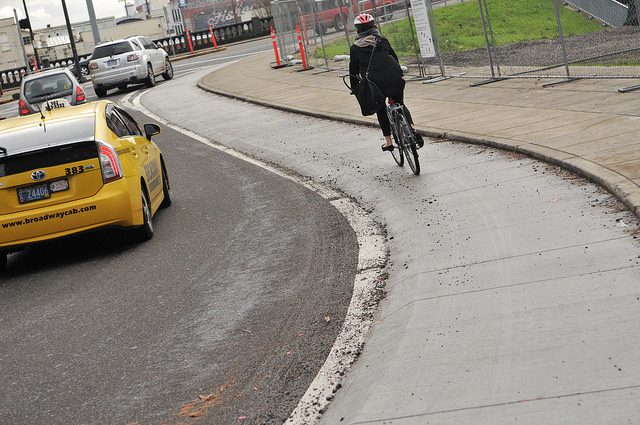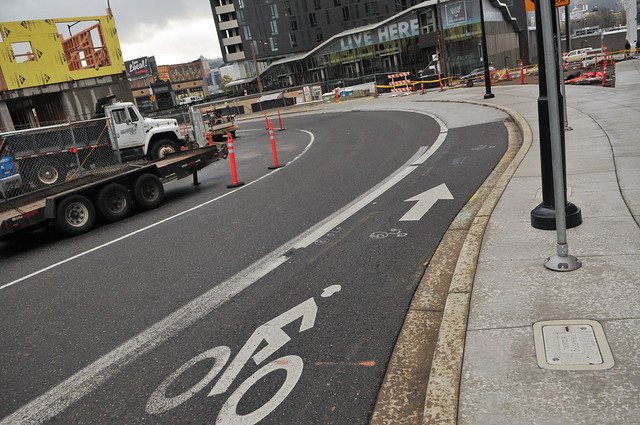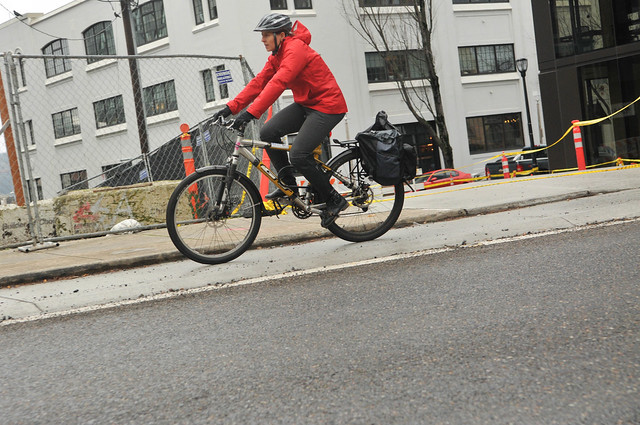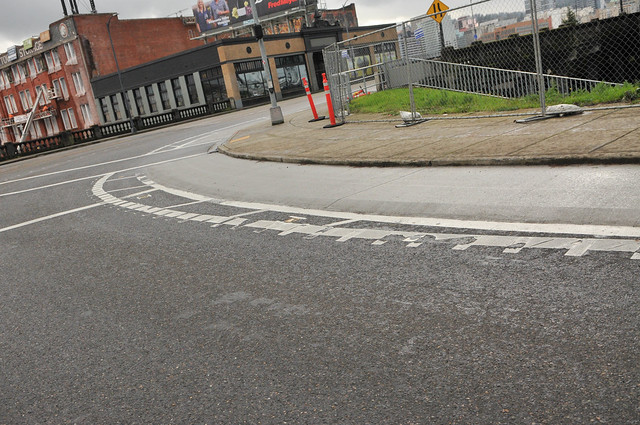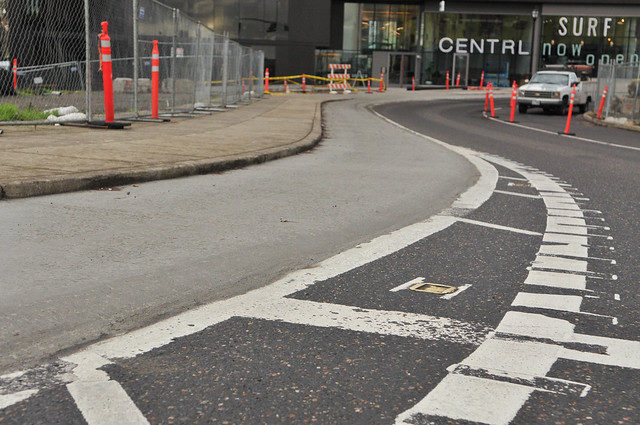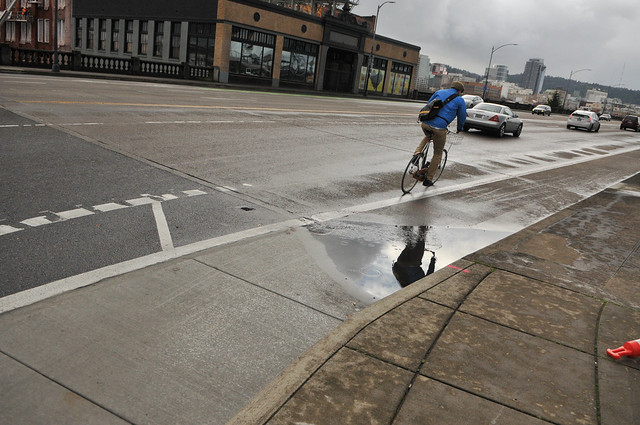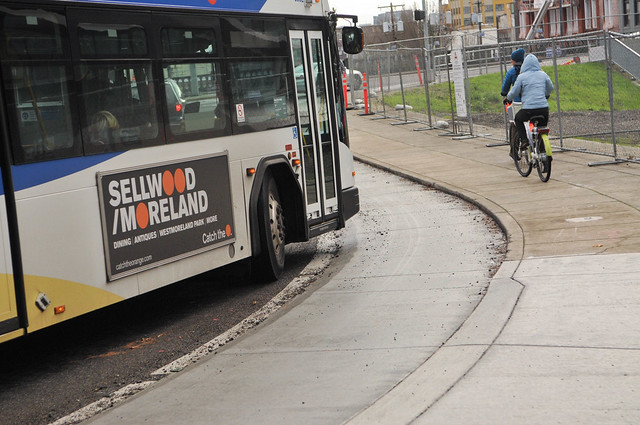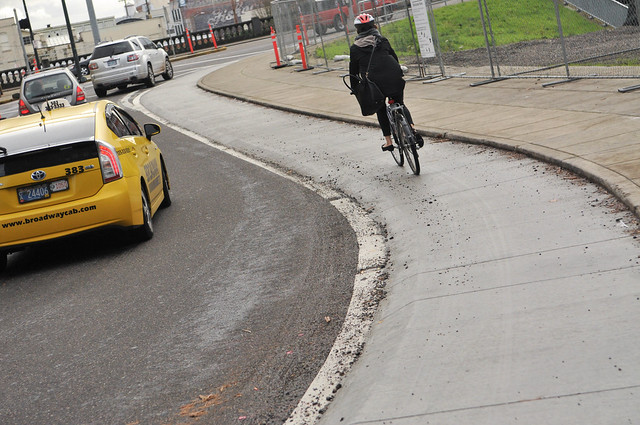
(Photos: J. Maus/BikePortland)
For years now the Portland Bureau of Transportation has tried to keep people from driving into the bike lane on the Couch curve at the eastern end Burnside Bridge. They’ve used buffer stripes, reflectors with LEDs inside them, and even rumble bumps — all without much success.

Have they finally figured it out?
Their latest attempt is a new concrete surface that’s raised a few inches above the adjacent roadway and that looks more like a sidewalk than a vehicle lane. We reported on this back in June and took a closer look at the finished product yesterday.
This section of Couch is a high-volume bikeway (especially during morning rush-hour) that collects traffic from inner southeast and northeast neighborhoods and then feeds right into Old Town/Chinatown via the Burnside Bridge. The road cross-section includes two standard vehicle lanes along with this new bike lane (which is the standard width of about five or six feet). Due to the curves (a design that was agreed upon in order to make the lot on the northwest corner of MLK and Burnside as large as possible for development), long buses and trucks need plenty of room to maneuver (see photo below).
The raised bike lane begins right at the start of the “s” curve after Couch crosses Martin Luther King Jr. Blvd. Bicycle users take a gradual ramp onto the lane and there’s a mountable curb with a very slight angle between the bike lane and the standard lane. Between the bike lane and the sidewalk there’s a three-inch curb that isn’t rounded at all. The width of the bike lane isn’t wide enough for side-by-side riding and, as local urban planner Nick Falbo pointed out on Twitter last week, it’s barely wide enough for a freight delivery bike.
Before we share more feedback and images, it’s important to know the urban context at this location. The area around the Couch curve has, quite literally, grown up a lot in the past few years. In every direction there are new developments that have brought hundreds of new residential units and well over 100,000 square feet of office and retail space. That means the future demand for space on adjacent public spaces (which includes streets) will grow considerably in the years to come.
Advertisement
It seems crazy to me that we have two lanes of motor vehicle traffic bisecting a thriving new neighborhood in our central city; but I digress.
The good news is that the raised bike lane and all the development have already slowed road users down. That’s a natural reaction to the built environment that we hope continues.
As for the new bike lane design, it’s a nice step forward. We’d love to see physical separation, but making the bike lane a different color and texture than the other lanes and raising it up a few inches is an improvement. One puzzling thing about the design is how the mountable curb is between the standard vehicle lanes and bike lanes, instead of between the bike lane and the sidewalk. This means people on bikes who want to pass will leave the (relative) safety of the bike-only lane and enter a lane shared with motor vehicles — instead of using the sidewalk.
The issue we’ve heard a lot about since this new bike lane was installed is the big puddle that has formed where it transitions back onto the Burnside Bridge (see photo below). The puddle was still there on Monday and the people I observed left the bike lane to go around it. This puddle needs to be fixed.
Here are more photos…
Another thing to keep in mind is that there will soon be a new, carfree road that connects to the Couch curve from NE 3rd Avenue. This will create a potential conflict point where people on bicycles merge from the new road onto the existing bike lane. As with all the changes around the east side of the Burnside Bridge, we’ll be watching that closely.
Have you ridden this new raised lane? What do you think? Would you like to see more of them in the central city?
— Jonathan Maus, (503) 706-8804 – jonathan@bikeportland.org
BikePortland is supported by the community (that means you!). Please become a subscriber or make a donation today.
